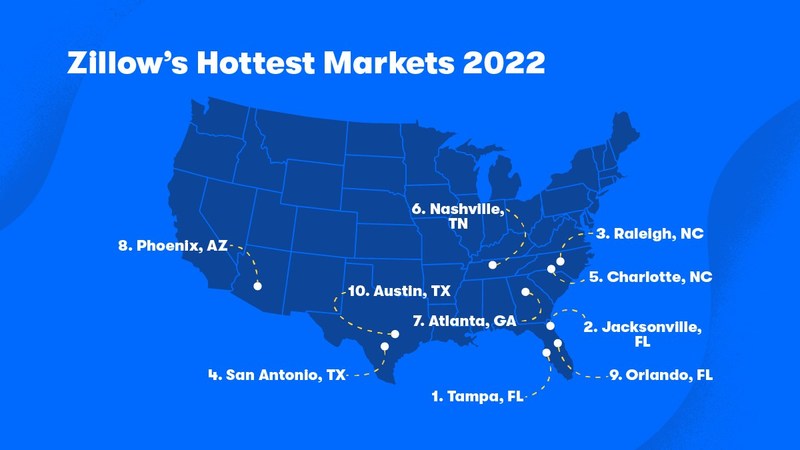
These look like the towns to which people from New York and California are moving. Excerpts:
The boomer tide in the for-sale housing market is expected to continue to rise for at least the next 8 years; younger millennials will be hitting first-time home buying age at about the same time, meaning the 2020’s will be a period of sustained underlying demand in the housing market.
Year by year, these effects will be felt differently across markets.
In 2022, the market with the most demographic lift in the for-sale market is Austin, with a trend suggesting the formation of 3.4% more owning households (assuming there are homes available for them to buy). Orlando follows at 2.8%, and then Tampa at 2.7%. Of the largest 50 markets, 29 have natural owner household growth exceeding 1% in one year, the rule-of-thumb rate at which the housing stock increases nationally. The markets with the least demographic pressure for growth are Pittsburgh, Hartford and Buffalo.
Risks
There are two large known risk factors for housing markets in 2022. First, mortgage interest rates are expected to rise in 2022, making home loans more expensive for aspiring buyers. At the margin, this would restrict the inventory accessible in the most expensive markets, potentially driving up competition for the lowest-priced homes in those markets or removing them from consideration altogether.
Historically, home value appreciation in the following markets has strong negative correlation with interest rates — so if interest rates go up, these markets are likely to slow the most: San Diego, New Orleans, Washington DC, Los Angeles, San Jose and San Francisco.
Second, forecasts on the performance of stocks are incredibly wide, with analysts’ 2022 year-end targets ranging from -7% to +13%, slower growth in any case than what we’ve seen in the last 2 years if not declines. A slower stock market would mean buyers are bringing relatively less to the table for a down payment in 2022.
This would most affect markets where there are a lot of first time buyers or where more buyers are entering from lower cost areas, bringing less equity from their previous home. (Or if housing is treated as an asset it could mean a substitution to housing in the next few months. What follows addresses only the downside risk.)
In the following markets, growth has strong positive correlation with stock market returns — so if the stock market falters next year, we’d expect home value growth in these places to slow disproportionately: Phoenix, Las Vegas, Cincinnati, Hartford, St. Louis, Miami, Cleveland, Los Angeles and San Jose.
https://www.zillow.com/research/zillow-2022-hottest-markets-tampa-30413/




Again the tyranny of statistics. A 5% increase in San Diego represents a lot more money than a 12% increase in Charlotte.
That said, the Atlanta, Nashville, Raleigh triangle is not only seeing rising housing prices but huge wealth inflows from Blue State refugees.
Another way to look at them:
Here are the 5 markets that witnessed the greatest decline in housing affordability over the past year, as of October:
1. Phoenix (33.7%)
2. Charlotte, N.C. (32.3%)
3. Tampa, Fla. (30.9%)
4. Jacksonville, Fla. (29.3%)
5. Memphis, Tenn. (27.5%)
Jacksonville…….oooooof!
Ponte Vedra is not Jacksonville. Therefore, I can’t think of any reason outside of family why anyone would willingly relocate to that part of Fla.
We’ve long seen the “declines in affordability” claim but that it isn’t all bad. The flip side of “declines in affordability” is “big paydays for long time residents.” It also makes property tax funded services flush with new revenues with no demand increase for services.
Of course the demand for more services comes later.
Oh, and “Hartford?” How much more obsolete for this century can you get? When I was a kid my dad would take me there to repair the big printing presses at the insurance companies. Hartford, too far from NYC, to tax expensive, Greek nation class demographics, weather, congestion, bleeding technology and youth. I will pass.